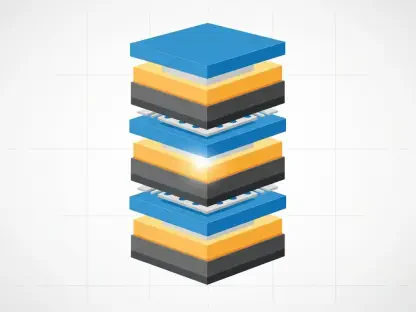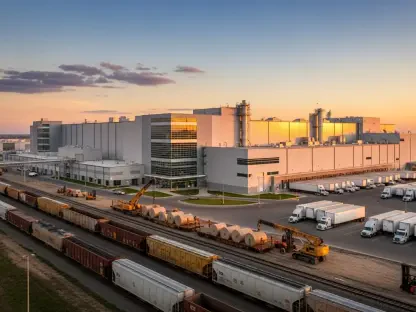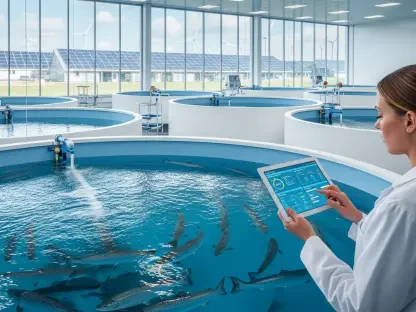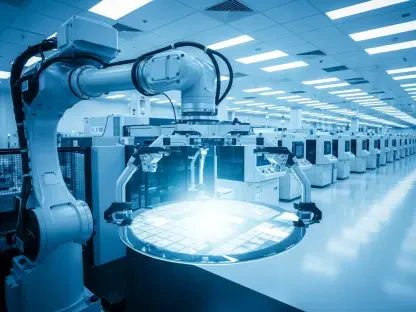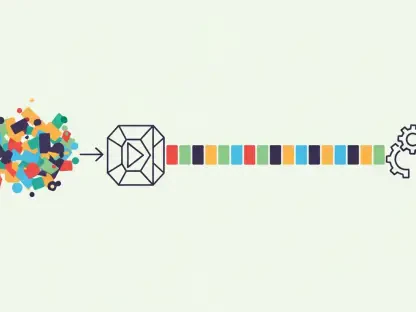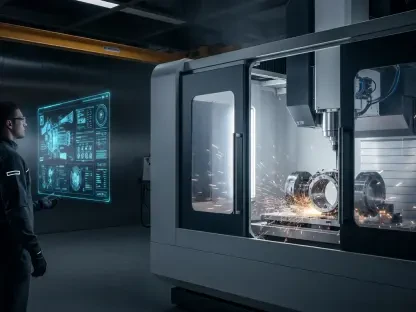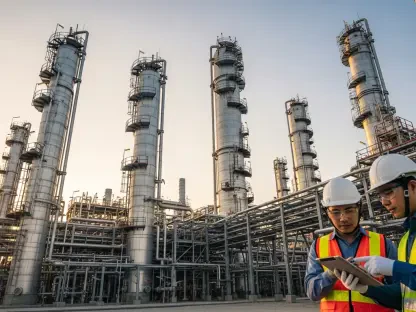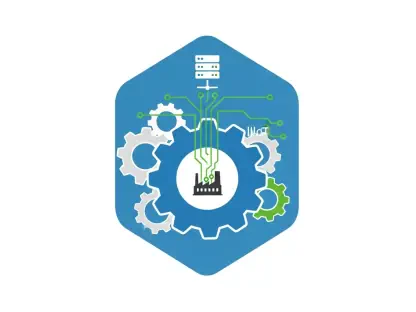Picture a future where nuclear reactors, essential for meeting the world’s clean energy demands, are no longer plagued by decade-long construction delays but are instead assembled in a fraction of the time through groundbreaking technology. The powerful combination of 3D printing, often referred to as additive manufacturing, and artificial intelligence (AI) is making this a tangible reality. At the forefront of this revolution are researchers at Oak Ridge National Laboratory (ORNL), who have demonstrated that these innovative tools can reduce the production timeline for critical reactor components from weeks to mere days. This dramatic shift holds the potential to expedite the deployment of nuclear facilities, addressing pressing global energy challenges. As the industry stands on the brink of transformation, the implications of faster builds, cost savings, and enhanced designs are matched by the need to ensure safety and reliability remain uncompromised. This convergence of cutting-edge methods offers a glimpse into a new era of energy infrastructure.
Revolutionizing Speed in Nuclear Construction
The most striking benefit of integrating 3D printing and AI into nuclear reactor construction lies in the unprecedented acceleration of manufacturing processes. Historically, creating essential components for these facilities has been a tedious endeavor, often stretching over months due to intricate designs and labor-intensive techniques. Projects like ORNL’s Hermes Low-Power Demonstration Reactor showcase how additive manufacturing can produce complex parts in just days, fundamentally altering the pace of development. By layering materials with precision, this technology eliminates many traditional bottlenecks, enabling a rapid turnaround that was once unimaginable. AI complements this by optimizing production workflows, ensuring that each step is executed with maximum efficiency. The result is a streamlined process that could redefine timelines for nuclear projects worldwide, pushing the boundaries of what the industry thought possible and setting a new standard for speed without sacrificing quality.
This rapid pace does more than just save time—it reshapes the strategic planning of energy infrastructure. With components available in days rather than weeks or months, project managers can respond more dynamically to energy demands or unexpected delays in other areas of construction. AI plays a pivotal role here by analyzing real-time data during manufacturing, making instantaneous adjustments to prevent errors and maintain structural integrity under extreme conditions like high radiation or heat. Such advancements are not merely incremental but signal a paradigm shift in how nuclear facilities are conceptualized and brought to life. For regions desperate for reliable clean energy, this speed translates into faster access to power, potentially bridging gaps in energy security. As these technologies continue to mature, their ability to compress schedules could become a cornerstone of modern nuclear engineering, promising a future where delays are the exception rather than the rule.
Efficiency and Cost Savings Through Innovation
Beyond the impressive speed, additive manufacturing introduces a level of efficiency that traditional methods simply cannot match. Conventional subtractive techniques often result in significant material waste as excess is carved away to form the desired shape, driving up costs and environmental impact. In contrast, 3D printing builds components layer by layer, using only what is necessary and drastically reducing scrap. This approach, when applied to the resource-heavy field of nuclear construction, offers substantial savings on raw materials, which are often specialized and expensive. Combined with the shortened production timelines, these efficiencies could lower the overall financial burden of building nuclear plants, making this form of clean energy a more viable option for widespread adoption. The economic ripple effect might encourage investment in nuclear projects, especially in areas previously deterred by prohibitive costs.
Moreover, the cost reductions enabled by these technologies extend beyond materials to labor and operational expenses. Faster production cycles mean less time spent on assembly, cutting down on workforce hours and associated overhead. AI further enhances this by automating design optimizations, reducing the need for extensive human intervention in iterative testing phases. This dual impact of material and operational savings positions nuclear energy to compete more effectively with other renewables like solar or wind, which have historically benefited from lower upfront costs. For policymakers and energy providers, this could shift the calculus in favor of nuclear as a cornerstone of sustainable energy strategies. As more facilities adopt these methods, the cumulative economic benefits might also drive down energy prices for consumers, aligning financial incentives with environmental goals in a way that reshapes the global energy market.
AI as a Catalyst for Precision and Maintenance
Artificial intelligence stands as a transformative force in this technological synergy, extending far beyond mere design support. By leveraging machine learning algorithms, AI analyzes vast datasets from simulations and historical builds to refine component designs for optimal performance under the harsh conditions of a nuclear environment. This capability ensures that parts are not only built faster but are also better suited to withstand stressors like intense heat and radiation. Additionally, AI’s predictive maintenance tools can forecast potential issues before they arise, allowing for preemptive action that minimizes downtime and enhances safety. Particularly for small modular reactors (SMRs), which prioritize scalability and adaptability, such precision is invaluable in ensuring consistent operation across diverse applications, marking a significant leap forward in nuclear engineering.
Equally critical is AI’s role in defect detection, a safeguard against the risks of rapid manufacturing. By scrutinizing real-time data during the 3D printing process, AI systems can identify anomalies or weaknesses that might escape traditional inspection methods. This is especially important in an industry where even the smallest flaw could have catastrophic consequences. The ability to catch and correct issues on the fly not only boosts reliability but also builds confidence in these new construction techniques. For SMRs, which are often deployed in varied and sometimes remote settings, such proactive monitoring ensures that each unit performs as intended, regardless of external challenges. As AI continues to evolve, its integration into nuclear manufacturing promises to set a benchmark for precision and foresight, potentially influencing other high-stakes industries to adopt similar data-driven approaches for quality control.
Addressing Safety and Reliability Challenges
Despite the excitement surrounding these advancements, significant hurdles remain, particularly in the realm of safety. Critics point out that the accelerated pace of 3D printing could introduce microscopic defects in components, flaws that might evade standard testing protocols and compromise long-term reactor integrity. Such risks are especially concerning given the unforgiving nature of nuclear operations, where even minor failures can lead to disastrous outcomes. The industry must grapple with developing enhanced inspection techniques that match the speed of production while ensuring no detail is overlooked. Balancing the drive for efficiency with the imperative of safety remains a central tension, as stakeholders recognize that public trust in nuclear energy hinges on an unblemished record of reliability and caution.
Further complicating matters is the reliance on AI, which, while powerful, is not infallible. Concerns arise over the quality and completeness of the data used to train these systems, as gaps or biases could result in undetected failure modes. If AI overlooks a critical issue due to incomplete training, the consequences could be severe, undermining the very efficiencies it seeks to provide. Addressing this requires not only robust datasets but also continuous validation of AI predictions against real-world outcomes. Industry experts advocate for a layered approach, combining AI-driven insights with human oversight and advanced testing to create a safety net. As these technologies are deployed in live projects, ongoing scrutiny and adaptation will be essential to mitigate risks, ensuring that the push for innovation does not come at the expense of the stringent standards that define nuclear energy’s legacy.
Regulatory Frameworks and Industry Adaptation
Keeping pace with technological progress, regulatory bodies like the Nuclear Regulatory Commission (NRC) are actively working to establish guidelines for certifying 3D-printed components. Drawing lessons from sectors like aerospace, where additive manufacturing has already gained traction, these frameworks aim to ensure that new methods meet the rigorous demands of nuclear applications. Early pilot projects, including a 3D-printed reactor core poised for operational testing, provide tangible proof of concept, demonstrating that these innovations can withstand real-world conditions. Yet, there is unanimous agreement across the industry that comprehensive testing and strict oversight are indispensable. Regulators and manufacturers alike must collaborate to refine standards, ensuring that each advancement is matched by a corresponding commitment to accountability.
This adaptation extends to the broader industry, which is gradually aligning itself with these emerging practices. Companies and research institutions are investing in training and infrastructure to integrate 3D printing and AI into their workflows, recognizing the competitive edge offered by faster, more cost-effective builds. International efforts, such as those by nuclear authorities in various countries, mirror this trend, fostering a global dialogue on best practices for implementation. However, the path forward requires balancing enthusiasm with prudence—rushing adoption without adequate safeguards could erode confidence in the technology. As more projects come online, the data gathered will inform iterative improvements to both regulatory approaches and industry standards, creating a feedback loop that strengthens the foundation for widespread use of these transformative tools in nuclear construction.
Paving the Way for a Safer Energy Future
Reflecting on the journey so far, the strides made through 3D printing and AI in nuclear reactor construction mark a turning point for the energy sector. These technologies have demonstrated their capacity to condense production timelines and trim costs while also refining the precision of critical components. At the same time, the industry confronts substantial safety and reliability challenges, prompting a renewed focus on rigorous testing and AI validation. Regulatory bodies have adapted with commendable foresight, laying down frameworks that balance innovation with accountability. Looking ahead, the next steps involve scaling these solutions through collaborative research to address material durability and production scalability. Continued investment in advanced inspection methods and international cooperation will be crucial to refine safety protocols. As lessons from past pilots inform future deployments, the nuclear sector stands poised to deliver clean energy more efficiently, provided the commitment to caution remains steadfast.


